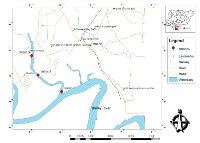Concentration of Polycyclic Aromatic Hydrocarbons (PAHs) in the Surface Water of Elechi Creek, Rivers State.
Keywords:
PAHs, Concentrations, Pollution, Surface Water, Elechi CreekAbstract
Polycyclic aromatic hydrocarbons (PAHs) also known as polynuclear aromatic hydrocarbons are class of organic chemical consisting of two or more fused aromatic rings. The concentration of PAHs in surface water of Elechi Creek River State detected the 16 priority PAHs outlined by WHO (2003) and USEPA (2007) at three stations namely:, NAPAS Company (POD)(S1), Master Energy (S2) and New Calabar River (S3). PAHs were extracted using the Liquid-Liquid Extraction method and their concentration were determined with the use of No:HP 5890 Series 11 Gas Chromatography-Flame Ionization Detector USA. The result showed that the total PAHs(ƩPAHs) concentration ranged from 2918.27µg/l to 9018.98µg/l with the mean value of 1123.36µg/l. The individual PAHs ranged between 37.05µg/l to 2500µg/l, while fluoranthene had the highest concentration, followed by Benzo(b)fluoranthene and
Chrysene(3340µg/l,2110µg/l and 2094.24µg/l) respectively while Phenathrane, Naphthalene and Indeno(1,2,3,c,d) pyrene had the least concentration of PAHs ( 301µg/l, 239.08µg/l, 211.56µg/l) respectively. The concentrations of PAHs detected showed predominance of high molecular weight PAHs (4-6 rings). This study concluded that the surface water of Elechi Creek was contaminated mostly with HPAH and these concentrations exceeded the maximum permissible limit of 10µg/l recommended by World Health Organization (WHO, 2003) and so, the water can adversely affect the biota found in the creek and there is also the possibility of their bioaccumulation and transfer to higher trophic levels through the food chain. There is also a plausible adverse effects upon the usage of this water for domestic and agricultural purposes.
Downloads
References
Abrajano,T.A., Jr. Yan, B. and O'malley, V. (2004). "High molecular weight petrogenic and pyrogenic hydrocarbons in aquatic environments”, Treatise on Geochemistry 9: 475-509: Elsevier Ltd.
Adedayo, A., Adeyemi, D., Uyimandu, J., Chigome, S. and Anyakora, C.(2012). “Evaluation of the levels of polycyclic aromatic hydrocarbons in surface and bottom waters of Lagos Lagoon, Nigeria”Africa. Journal Pharmacy, pp. 58-74.
Ana, GREE, Sridhar, MKC. andChinda, A.(2005). “The impact of a chemical fertilizer plant effluents on a typical tidal creek in Southern Nigeria”.
Journal of African WaterResources and Environment(AQUATERRA) 1(1):39-49.
Anyakora,Chimezie and Herbert Coker(2006).“Determination of polynucleararomatichydrocarbons (PAHs) in selected water bodies in the Niger Delta”, Africa. Journal of .Biotechnology 5 (21) 2024–2031.
Ardag, H., Ozel, M.Z. and Sen, A. (2011).“Polycyclic Aromatic Hydrocarbons in Water from the Menderes River, Turkey”.Bulletin of Environmental Contamination and Toxicology, 86, 221-225.
Chindah, AC., Braide, SA. and Osuamkpe, A. (2003).” Levels of hydrocarbons and heavy metals in sediment and a decapods crustacean (crabUcatangeri) in the Bonny/ New CalabarRiver”Estuary,Niger Delta.Chindah,AC. And Braide SA., (2003). “Cadmium and Lead concentrations in fish species of a brackish wetland / upper Bonny Estuary, Niger Delta”.Journal of Nigeria Environmental Society. (JNES). 1 (3): 399-405.
Dambo, WB. and Ekweozor IKE. (2000).” Ecotoxicology of Heavy metals and petroleum related compounds on the mangrove Oyster(crassostreagasar) from the lower Bonny Estuary, Nigeria, Nigeria.Ph.D. Dissertation, Rivers State University of Science and Technology, Port Harcourt, Nigeria.
Davies, O.A., Allison, M. E. and Uyi, H. S. (2006).“Bioaccumulation of heavy metals in water, sediment and periwinkle (Tympanotonusfuscatus) from the Elechi Creek, Niger-Delta, Nigeria”.African Journal of Biotechnology, 5:968-973.
Diggs, D.L., Huderson, A.C., Harris, K.L., Myers, J.N., Banks, L.D. and Rekhadevi, P.V.(2011). “Polycyclic aromatic hydrocarbons and digestive tract cancers: a perspective”. Journal of Environmental Science and Health, 29 (4) (2011) 324–357.
Djozan, D.J. and Assadi, Y.(1999).” Monitoring of polycyclic aromatic hydrocarbons in water using headspace solid-phase microextraction and capillary gas chromatography”Microchemical Journal,63,276-284.
Doong, R.A., Peng, C.K., Sun, Y.C., Liao, P.L. (2002). ”Composition and distribution of organchlorine pesticide residues in surface sediments from Wu-shi River Esturay, Taiwan”. Marine PollutionBulletin 45,246-253.
Doong, R.A. and Lin, Y.T. (2004). Characterization and distribution of polycyclic aromatic hydrocarboncontaminations in surface sediments and water from Gao-ping River, Taiwan. Water Res. 2004,38, 1733–1744.
Eno, Anietie Moses, BasseyAnieEtuk and Essien Daniel Udosen (2015). ”Levels, Distribution and Sources of Polycyclic Aromatic hydrocarbon in surface water in the lower Reach of Qua Iboe River Estuary, Nigeria”.American Journal of Environmental Protection 4(6): 334-343.
Essumang, D. K., Adokoh, C. K., Afriyie,J. and Mensah,E. (2009) “Source assessment and analysis of PAHs in the Oblogo waste disposal sites and some water bodies in and around the Accra metropolis of Ghana”.Journal of water Resources vol.1 pp 456-468.
Ezemonye, L.(2006) “Polycyclic aromatic hydrocarbons (PAH) in aquatic environment of Niger Delta of Nigeria (Surface water and sediment)”International Journal of Chemistry, 6 (2006), pp. 135-147.
Farshid, Kafilzadeh (2015).“Distribution and sources of polycyclic aromatic hydrocarbons in water and sediments of the SoltanAbad River, Iran”. Egyptian Journal of Aquatic Research 41, 227–231.
Fetzer, J. (2000). “The Chemistry and Analysis of the Large Polycyclic Aromatic Hydrocarbons.New York”: Wiley Press.
G R E E, Ana, Sridhar M K C. and EmeroleG O.(2004). “Contamination of surface waters by polycyclic aromatic hydrocarbons in two Nigerian coastal communities”.Journal of Environmental Health ResearchVolume 11 Issue 2
Ibiebele, D.D.(1986).“Point-source inputs of petroleum wastewater into the Niger Delta, Nigeria”. Science of the Total Environment. 52:233–238. doi: 10.1016/0048-9697(86)90123-3.
Igwe, J.C. and Ukaogo, P.O. (2015). ”Environmental Effects of Polycyclic Aromatic Hydrocarbons Journal of Natural Sciences Research
www.iiste.org ISSN 2224-3186 (Paper) ISSN 2225-0921 (Online) Vol.5.,No.7.
Jack, D.Nwineewii and Abiye, C. Marcus (2015). “Polycyclic Aromatic Hydrocarbons (PAHs) In Surface Water and Their Toxicological Effects in Some Creeks of South East Rivers State (Niger Delta) Nigeria”. Journal of Environmental Science, Toxicology and Food Technology (IOSR-JESTFT) e-ISSN: 2319-2402,p- ISSN: 2319-2399.Volume 9, Issue 12 Ver. II (Dec. 2015), PP 27-30.
Joil, José Celino, Henry, Xavier Corseuil, MarildaFernandes and Gisele, Mara Hadlich (2012).“Persistent toxic substances in surface water of TodosOs Santos Bay, Brazil”. Resources and Environment, 2(4): 141-149 DOI: 10.5923/j.re.20120204.03.
Kiss, G.,Varga-Puchony, Z., Tolnai, B., Varga, B.,Gelencser A., Krivacsy, A., and Halavey, J. (2001).“The seaosonal changes in the concentration of polycyclic aromatic hydrocarbons in precipitation and aerosol near Lake Balaton, Hungary”, Environmental Pollution, 114, 53-61.
Krober, B. and Hackl, M.(1989). “Report on orientation measurements on dangerous, organic compounds in waste water pipes, sewage work and waters in the Federal State of Hessen {1985 – 1988}) Wiesbaden”, Hessen State Office for the Environment, pp 225-288.
Magdalena, R., Lidia, W., and Jacek, N. (2006). “Analytical Procedures for PAH and PCB Determination in Water Samples—Error Sources”. Critical Reverse Analytical Chemistry 36: 63 -72.
Malik, A., Verma, P., Sengh, A.K. and Sengh, K.P. (2011).’Distribution of polycyclic aromatic hydrocarbons in water and bed sediments of the Gomti River, India”.Environment Monitor Assessment 172 (1-4): 529-545.
NRC (National Research Council) (2003). Diesel cars: benefits, risk, and public policy, National Academy press, Washington, DC.
Obayori, O.S. and Salam, L.B., (2010). “Degradation of polycyclic aromatic hydrocarbons: role of plasmids”. Science Resources Essays. 5 (25), 4093–4106.
Ogamba, EN., Ekweozor, IKE., Daka, ER.(2005).”The influence of human activities on the zooplankton of Elechi Creek complex in Niger Delta. Africa Journal Of Environmental Pollution and Health 4(2): 31-38
Ogunfowokan, AO Asubiojo, OJ and Fatoki, OS. (2003). “Isolation and determination of polycyclic aromatic hydrocarbons in surface runoff and sediments”.Water, air and soil pollution vol 147 (4) pp 245-261.
Okafor, EC. and Opuene, K.(2007).“Preliminary assessment of trace metals and polycyclic aromatic hydrocarbons in the sediments of
Taylor Creek, Southern Nigeria”.International Journal of Environmental Science Technology., 4(2):233–240.
Okoro, D.(2008). “Source determination of polynuclear aromatic hydrocarbons in water and sediment of a creek in the
Niger Delta region”.African Journal of Biotechnology Vol. 7 (3), pp. 282-285.
Olof, Lindén and Jonas Pålsson (2013).“Oil Contamination in Ogoniland, Niger Delta”Ambio. 2013 Oct; 42(6): 685–701. Published online 2013 Jun 8.
Olsson, A.C. Fevotte,J. Fletcher, T. Cassidy, A. Mannetje, A. and Brennan, P.(2010) ”Occupational exposure to polycyclic aromatic hydrocarbons and lung cancer risk: a multicenter study in Europe”. Occupational and Environmental medicine 67 (2010) 98– 103.
Opuene, K., Agbozu, I.E., Adegboro, O. O.(2009). “A critical appraisal of PAH indices as indicators of PAH source and composition in Elelenwo Creek, southern Nigeria”. The Environmentalist 29:47–55.
Opuene, K. (2004). “Water quality levels and impacts of heavy metals and polycyclic aromatic hydrocarbons in the Taylor Creek Aquatic Ecosystem, Bayelsa State, Nigeria.Ph.D Thesis of the University of Nigeria, Nsukka, Nigeria.
Oris, J., Hatch, AC., Weinstein, JE., Findlay, RH., McGinn, PJ., Diamond, SA., Garret, R., Jackson,W., Burton, GA., Allen, B. (1998). “Toxicity of
ambient levels of motorized watercraft emissions to fish and zooplankton in Lake Tahoe, California/Nevada, USA”. Presented at the 8th Annual Meeting of the Society of Environmental Toxicology and Chemistry (SETACEurope) 14-18 April, 1998. University of Bordeaux, Bordeaux, France.
Takalani, JN., Teunis, VR., Olalekan, SF.,(2014).“Determination and distribution of polycyclic aromatic hydrocarbons in rivers,
surface runoff, and sediments in and around Thohoyandou, Limpopo Province, South Africa”. Water South Africa vol.40 n.3 Pretoria.
SEPA (Scottish Environment Protection Agency) (2010).“Water Pollution Arising from Land Containing Chemical Contaminants”.State of
Hessen {1985 – 1988}) Wiesbaden, Hessen State Office for the Environment, pp 225-2 88.
United States Environmental Protection Agency (USEPA, 2007). The national water quality inventory report to congress for the 2002 reporting cycle: A profile. Washington DC.: United States Environmental Protection Agency, 841-843.
Upadhi, F, Wokoma, OAF (2012). “Examination of some pesticide residues in surface water, sediment and fish tissue of Elechi Creek, Niger Delta”. Nigeria Resources Journal of Environmental Earth Science. 4(11):939-944.
USEPA (2003).“Methods for organic chemical analysis of municipal and industrial wastewater”, method 610 –Polynuclear aromatic hydrocarbons 146 - 152.
USEPA (2003b).‘The determination of polycyclic aromatic hydrocarbons in soil by dichloromethane extraction using gas chromatography with mass spectrometric detection”.Methods for the Examination of Waters and Associated Materials.
USEPA (2003).“Polynuclear aromatic hydrocarbons; Appendix A: Methodsfor organic chemical analysis of municipal and industrial wastewater”; CWA methods for use at 40 CFR 136. http://www.epa.gov/waterscience/methods/method/organics/610.pdf.
WHO (1998) “Polynuclear aromatic hydrocarbons. In: Guidelines for drinking-water quality, 2nd edition. Health criteria and other supporting information”, Geneva 2: 123-152.
WHO (1998).“Non-heterocyclic polycyclic aromatic hydrocarbons”. Geneva, World Health Organization, International programme on chemical safety (Environmental Health Criteria, 202).
WHO (2003).“Background document for preparation of WHO Guidelines for drinking-water quality”. Geneva, world Health Organization.
World Health Organization (WHO) (2011).“Guidelines for Drinking-waterQuality”-4th edition. WHO Library Cataloguing-in-Publication Data.ISBN 97892 4 154815 1.564 pp.
Yuyun, Chen RuiJia and Shengke, Yang (2015). “Distribution and Source of Polycyclic Aromatic Hydrocarbons (PAHs) in Water Dissolved Phase, Suspended Particulate Matter and Sediment from Weihe River in Northwest China”.International Journal of Environmental Research and Public Health 12, 14148-14163.
Zakania, MP., Mahat, AA. (2006). “Distribution of Polycyclic Aromatic Hydrocarbon (PAHs) in sediments in the Langat Estuary”.Coastal Marine Science. 30(1):387 - 395.
Zhang, W., Chaohai, W., Chunhua, F., Zhe, Y., and Man, R.. (2011).“Distribution and health-risk of polycyclic aromatic hydrocarbons in soils at a coking plant”. Journal of Environmental Monitoring 13: 3426-3

Downloads
Published
Issue
Section
License

This work is licensed under a Creative Commons Attribution-NonCommercial-ShareAlike 4.0 International License.







